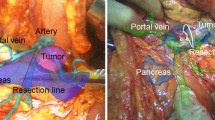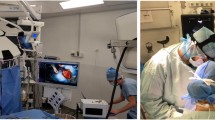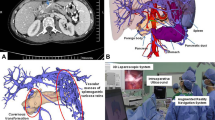Abstract
Background/purpose
The aim of this study was to evaluate the utility of an image display system for augmented reality in hepatobiliary surgery under laparotomy.
Methods
An overlay display of organs, vessels, or tumor was obtained using a video see-through system as a display system developed at our institute. Registration between visceral organs and the surface-rendering image reconstructed by preoperative computed tomography (CT) was carried out with an optical location sensor. Using this system, we performed laparotomy for a patient with benign biliary stricture, a patient with gallbladder carcinoma, and a patient with hepatocellular carcinoma.
Results
The operative procedures performed consisted of choledochojejunostomy, right hepatectomy, and microwave coagulation therapy. All the operations were carried out safely using images of the site of tumor, preserved organs, and resection aspect overlaid onto the operation field images observed on the monitors. The position of each organ in the overlaid image closely corresponded with that of the actual organ. Intraoperative information generated from this system provided us with useful navigation. However, several problems such as registration error and lack of depth knowledge were noted.
Conclusion
The image display system appeared to be useful in performing hepatobiliary surgery under laparotomy. Further improvement of the system with individualized function for each operation will be essential, with feedback from clinical trials in the future.


Similar content being viewed by others
References
Marescaux J, Clement JM, Tassetti V, Koehl C, Cotin S, Russier Y, et al. Virtual reality applied to hepatic surgery simulation: the next revolution. Ann Surg. 1998;228:627–34.
Lamada W, Glombitza G, Ficher L, Chiu P, Cárdenas CE Sr, Thorn M, et al. The impact of 3-dimensional reconstruction on operation planning in liver surgery. Arch Surg. 2000;135:1256–61.
Endo I, Shimada H, Sugita M, Fujii Y, Morioka D, Takeda K, et al. Role of three-dimensional imaging in operative planning for hilar cholangiocarcinoma. Surgery. 2007;142:666–75.
Aggarwal R, Crochet P, Dias A, Misra A, Ziprin P, Darzi A. Development of a virtual reality training curriculum for laparoscopic cholecystectomy. Br J Surg. 2009;96:1086–93.
Saito S, Yamanaka J, Miura K, Nakao N, Nagao T, Sugimoto T, et al. A novel 3-D hepatectomy simulation based on liver circulation: application to liver resection and transplantation. Hepatology. 2005;41:1297–304.
Yonemura Y, Taketomi A, Soejima Y, Yoshizumi T, Uchiyama H, Gion T, et al. Validity of preoperative volumetric analysis of congestion volume in living donor liver transplantation using three-dimensional computed tomography. Liver Transpl. 2005;11:1556–62.
Yamanaka J, Saito S, Fujimoto J. Impact of preoperative planning using virtual segmental volumetry on liver resection for hepatocellular carcinoma. World J Surg. 2007;31:1249–55.
Satou S, Sugawara Y, Kishi Y, Kaneko J, Matsui Y, et al. Preoperative estimation of right sector graft by three-dimensional computed tomography. Transplant Proc. 2007;39:145–9.
Hattori A, Suzuki N, Hashizume M, Akahoshi T, Konishi K, Yamaguchi S, et al. A robotic surgery system (da Vinci) with image guided function system architecture and cholecystectomy. Stud Health Technol Inform. 2003;94:110–6.
Sugimoto M, Yasuda H, Koda K, Suzuki M, Yamazaki M, Tezuka T, et al. Image overlay navigation by markerless surface registration in gastrointestinal, hepatobiliary and pancreatic surgery. J Hepatobiliary Pancreat Sci. 2010;17:629–36.
Herline AJ, Stefansic JD, Debelak JP, Hartmann SL, Pinson CW, Galloway RL, et al. Image-guided surgery. Arch Surg. 1999;134:644–50.
Cash DM, Miga MI, Glascow SC, Dawant BM, Clements LW, Cao Z, et al. Concepts and preliminary data toward the realization of image-guided liver surgery. J Gastrointest Surg. 2007;11:844–59.
Robb RA. The biomedical imaging resource at Mayo clinic. Guest editorial. IEEE Trans Med Imaging. 2001;20:854–67.
Robb RA, Barillot C. Interactive display and analysis of 3-D medical images. IEEE Trans Med Imaging. 1989;8:217–26.
Robb RA, Hanson DP, Karwoski RA, Larson AG, Workman EL, Stacy MC. Analyze: a comprehensive, operator-interactive software package for multidimensional medical image display and analysis. Comput Med Imaging Graph. 1989;13:433–54.
Lamade W, Vetter M, Hassenphlug P, Thorn M, Meinzer HP, Herfarth C. Navigation and image-guided HBP surgery: a review and preview. J Hepatobiliary Pancreat Sci. 2002;9:592–9.
Sugimoto M. Recent advances in visualization, imaging, and navigation in hepatobiliary and pancreatic sciences. J Hepatobiliary Pancreat Sci. 2010;17:574–6.
Shuhaiber JH. Augmented reality in surgery. Arch Surg. 2004;139:170–4.
Morikawa S, Inubushi T, Kurumi Y, Kurumi Y, Naka S, Haque HA, et al. MR-guided microwave thermocoagulation therapy of liver tumors: initial clinical experience using a 0.5T MR system. Magn Reson Med Sci. 2005;4:89–94.
Shekhar R, Dandekar O, Bhat V, Philip M, Lei P, Godinez C, et al. Live augmented reality: a new visualization method for laparoscopic surgery using continuous volumetric computed tomography. Surg Endosc. 2010;24:1976–85.
Nakamoto M, Nakada K, Sato Y, Konishi K, Hashizume M, Tamura S. Intraoperative magnetic tracker calibration using a magneto-optic hybrid tracker for 3-D ultrasound-based navigation in laparoscopic surgery. IEEE Trans Med Imaging. 2008;27:255–70.
Sato Y, Nakamoto M, Tamaki Y, Sasama T, Sakita I, Nakajima Y, et al. Image guidance of breast cancer surgery using 3-D ultrasound images and augmented reality visualization. IEEE Trans Med Imaging. 1998;17:681–93.
Conflict of interest
None.
Author information
Authors and Affiliations
Corresponding author
Electronic supplementary material
Below is the link to the electronic supplementary material.
About this article
Cite this article
Okamoto, T., Onda, S., Matsumoto, M. et al. Utility of augmented reality system in hepatobiliary surgery. J Hepatobiliary Pancreat Sci 20, 249–253 (2013). https://doi.org/10.1007/s00534-012-0504-z
Published:
Issue Date:
DOI: https://doi.org/10.1007/s00534-012-0504-z




